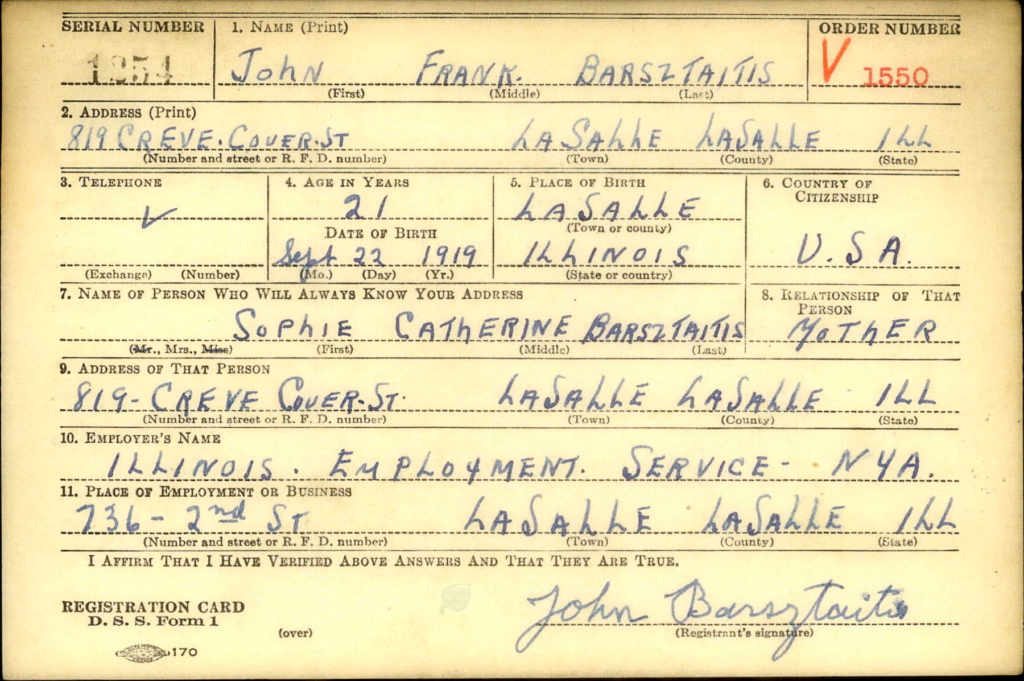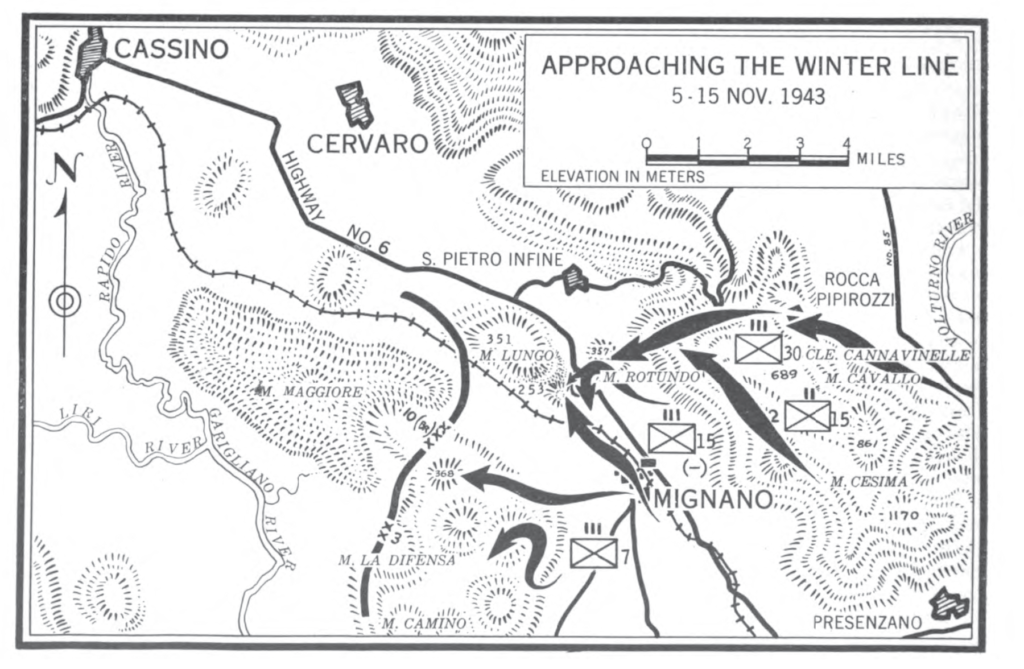John Frank Barsztaitis was born on September 22, 1919, in LaSalle, Illinois, to Frank and Sophie Jozwiak Barsztaitis. His father, Frank, was born in Jurbakas, Lithuania, and left his country at age 25 to travel to America with his 17-year-old sister Petronnela. Their older brother, Izidor, had made the same journey not long before. Frank married Sophie on April 30, 1912—five years after arriving in America.
Frank and Sophie had their first child, Emily, about a year or so after marrying. They had three more daughters before John was born in 1919. Prior to John’s birth, Frank had been working as a coal miner, was naturalized, and had purchased his own home in LaSalle at 819 Creve Coeur street.
Four more children were born to Frank and Sophie after John’s birth: a daughter and three more sons, the last two of whom were twins. When John was 10, he was still living in the family home on Creve Coeur and attending school with his siblings. His older sister Emily was working at Westclox—a local clock factory. John eventually completed seventh grade then perhaps began working following examples set by his older siblings who also left school to take jobs. By age 20 John was employed by the local employment office as a janitor. He had grown into a tall man standing at six feet and weighing 167 pounds with brown eyes and brown hair. About a month after turning 21, he registered for the draft in LaSalle on October 16, 1940. Four months later, on February 10, 1941, John enlisted in the U.S. Army.

When John entered the Army, the United States had not yet officially entered the war. John was assigned to the 30th Infantry Regiment, 3rd Infantry Division and, at some point, promoted to private first class. While still stateside, his regiment was stationed at Fort Lewis, Washington, and then later at Fort Ord, California. Once orders were received to move overseas, the Division left California, arriving at Camp Pickett in Virginia on September 20, 1942. A month later, the Division sailed for Morocco on October 24, 1942, landing as part of “Operation Torch” at the town of Fedala on November 8, 1942.
The 3rd Division captured Casablanca a few days after landing then later the next year made their way east to Tunisia. From there they traveled to Sicily and then onto the continent landing near Salerno, Italy, on September 18, 1943. The troops soon began moving north through the mountains of southern Italy. On October 26, 1943, all three battalions of the 30th were aligned to cross the flats of the valley leading to Mount Nicola from the east. Under great fire they managed to secure one of the highest hills along the ridge. By the next day the 3rd Battalion entered the city of Pietravairano. At the same time, the 1st and 2nd Battalions moved to take the town of Vairano.
As troops continued north towards Mignano the weather turned colder, the rains drove harder, and the mountains rose higher. Using Highway No. 6 as a guide, they advanced assisting the 45th division in their crossing of the Volturno during the night of November 3rd through the 4th. “On November 5, the Division was poised to make its attack on Mignano, which is situated in a wide gap, protected from the east and west by lofty peaks.” Mount Lungo and Mount Rotundo rose out of the gap to the north of Mignano. The soldiers faced these mountains which held “gun positions, minefields and tank traps.”

On the night of November 5th to the 6th, the 30th Infantry moved north from Presenzano and attacked Rocca Pippirozzi early in the morning of the 6th. Their mission was to secure Mount Rotundo. The treacherous, steep terrain and narrow paths up the mountain became even more dangerous to navigate with the enemy securely entrenched and able to provide intense resistance. While working his way up the mountain with his regiment, John Barsztaitis took a fatal hit to the head from an explosion of an artillery shell.
PFC John Frank Barsztaitis was buried in a temporary cemetery and later moved to Block G, Row, 1, Grave 27 in the Sicily-Rome American Cemetery in Nettuno Italy. The U.S., Headstone and Interment Records for U.S., Military Cemeteries on Foreign Soil, 1942-1949, indicate he was awarded the Purple Heart. He would have also received the Combat Infantryman Badge and the following medals: Army Good Conduct Medal, American Defense Service Medal, American Campaign Medal, Europe/African/Middle Eastern Campaign Medal, and the World War II Victory.
This story is part of the Stories Behind the Stars project (see www.storiesbehindthestars.org). This is a national effort of volunteers to write the stories of all 421,000+ of the US WWII fallen saved on Together We Served and Fold3. Can you help write these stories? These stories will be accessible via smartphone app at any war memorial or cemetery.
If you noticed anything erroneous in this profile or have additional information to contribute to it, please email feedback@storiesbehindthestars.org.
SBTSProject/Illinois/LaSalle
SBTS Historian: Pam Broviak
You can also access this story at the following sites:
Sources:
- U.S., Headstone and Interment Records for U.S., Military Cemeteries on Foreign Soil, 1942-1949, John F Barsztaitis, Ancestry.
- U.S. Census 1920, Frank Barsztaitis, FamilySearch.
- U.S. Census 1930, Frank Barsztaitis, FamilySearch.
- U.S. Census 1940, Frank Barsztaitis, Ancestry.
- City Directory, LaSalle, Illinois, 1938, Ancestry.
- City Directory, LaSalle, Illinois, 1940, Ancestry.
- New York, U.S., Arriving Passenger and Crew Lists (including Castle Garden and Ellis Island), 1820-1957, Franz and Petronella Barstaitis, 1907>Jul>25>Prinzess Alice, Ancestry.
- LaSalle Genealogical Guild, Marriage Database Index, Frank Barsztaitis to Sophie Jozwiak.
- U.S., World War II Hospital Admission Card Files, 1942-1954, Ancestry.
- U.S., World War II Draft Cards Young Men, 1940-1947, John Frank Barsztaitis, Ancestry.
- U.S., World War II Draft Registration Cards, 1942, Frank Barsztaitis, Ancestry.
- World War II, Library of Congress.
- “History Of the Third Infantry Division In World War II,” Donald G. Taggart, editor, Internet Archive.
- https://www.findagrave.com/memorial/56306327/john-francis-barsztaitis.